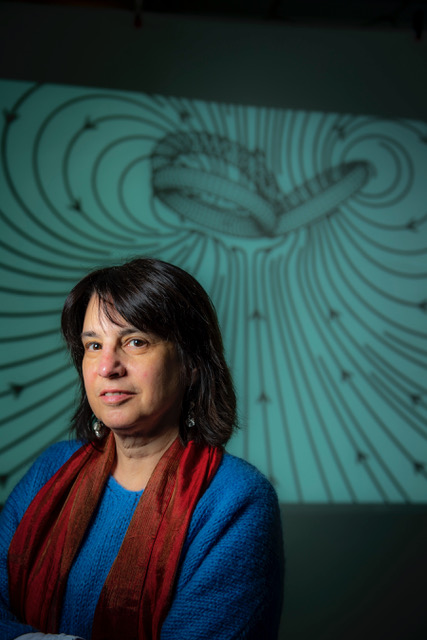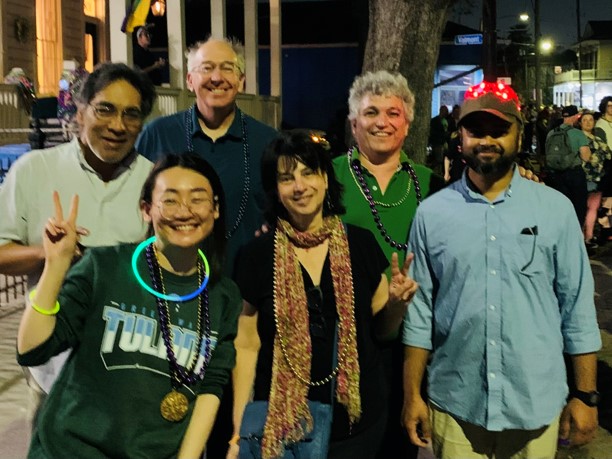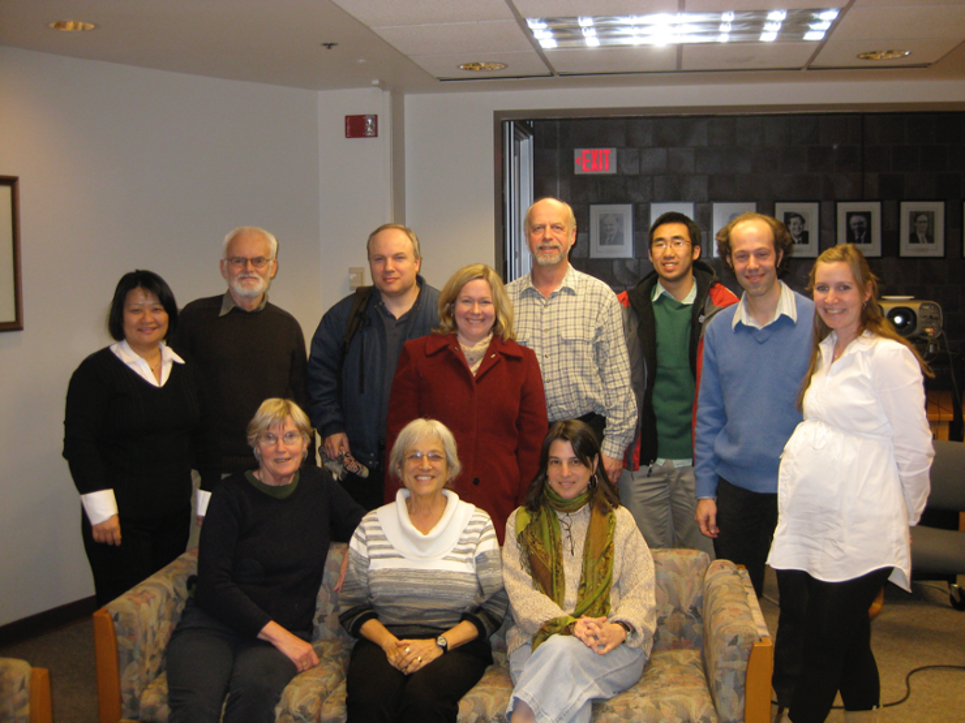
I grew up in a big, boisterous Italian-American family in Brooklyn who believed that New York City was the center of the universe. As a first-generation college student, I attended Pace University in lower Manhattan with the intention of becoming an accountant. By chance, I was assigned a faculty advisor from the math department. He saw my score of 5 on the advanced placement exam in BC calculus and exclaimed "Young lady, you should be a math major!". Even though I got excellent grades in high school, no teacher or counselor had ever encouraged me to pursue math or science. I changed my major to math. A few years later, the same advisor exclaimed, “You should go for a PhD!". Honestly, besides knowing that some faculty had “Dr.” before their names, I really had no idea what a Ph.D. meant. Since Pace was an undergraduate institution, there weren’t any TAs that served as role models. Nevertheless, I applied to NYU, a mile or so uptown. (Of course, culturally, there was no scenario where I would move from my parents’ house at that time.) I was unaware of the prestige of NYU’s Courant institute, and I did have a straight A average, so I was undeterred. Little did I know.
As a local applicant, I was invited to an in-person interview with the graduate chair. He leaned back, clasped his hands, and asked, “What does your father think that his little girl wants to do something like this?". It is no surprise, then, that my first year at Courant was a struggle – foremost, I did not have the same level of preparation as most of the other students, and, like the graduate chair, a small minority of those in power had a definite idea of who should be a mathematician.

Lisa Fauci, first year of graduate school at Courant Institute, Washington
Square Village, NYU, 1982.
After my first year at Courant, the story gets brighter. The immersed boundary method, in its infancy, was being advanced by Charlie Peskin to model blood flow in the heart. This is a computational method that couples elastic structures with a surrounding, incompressible fluid. Stephen Childress had just published his book “Mechanics of Swimming and Flying”, which presents the basic fluid dynamics of a fascinating array of systems, from flagellated microorganisms to shedding of vortices by fish to the aerodynamics of bird flight. I enrolled in special topics courses offered by both Charlie and Steve, and, yes, I was in the right place at the right time. It was clear that a student should try adapting the new computational framework to model flexible swimmers that had, up until then, been investigated using analytical methods. How exciting it was to work with Charlie and Steve – two brilliant scientists and teachers, who are incredibly supportive, patient, and kind. I am fortunate to have been mentored by them throughout my career. Fast forwarding from my graduate school days until now, the biophysics of organismal locomotion has remained the unifying theme of most of my research.

Tulane Mathematics at a Mardi Gras parade 2023: from left to right: Ricardo Cortez, Hongfei Chen,
Ken McLaughlin, Lisa Fauci, Victor Moll, Adnan Morshed.
I was hired in a tenure-track position at Tulane University directly upon receiving my Ph.D. This was not as unusual as it would be now. My husband, Victor Moll, also a Courant Ph.D., was just finishing a postdoctoral position at Temple University, and was also hired into a tenure-track position at Tulane. Although New Orleans was far from New York City, my father was an avid college football fan, and at one time was very impressed with Tulane’s half-time promotional video touting the University - so he approved. Victor and I thought it would be fun to be in New Orleans for a couple of years. That was 1986. It has been fun. A lot of fun. We never left.
As a junior faculty member, I concentrated on methodological improvements of the immersed boundary method and worked with other applied mathematicians on applications including ciliary and flagellar propulsion, peristaltic pumping, biofilm processes, and bioconvection. The field of biological fluid dynamics, at least within the mathematics community, was just beginning to embrace computational simulations as a tool, along with more traditional asymptotic approaches. There were lots of intriguing problems to work on! At times it required a thick skin, as some of the veterans quickly dismissed this new line of attack.
I had been focused on microscopic biological systems where viscosity dominates and inertia could be neglected, yet I was not taking advantage of the simplified Stokes equations that could describe the fluid dynamics. The central idea of the immersed boundary method is to treat flexible structures as a source of regularized forces in the Navier-Stokes equations. Ricardo Cortez, now my good friend and collaborator, joined the Math Department at Tulane at the turn of the millennium. Ricardo had the revelation that with a judicious choice of a regularized delta-function (blob) as a source in the Stokes equations, one could write down an analytic solution for the velocity that is defined everywhere and is everywhere incompressible. Thus was born the method of regularized Stokeslets. This has become a standard numerical method for studying fluid-structure interactions at the microscale. How fortunate I have been to “come in on the ground floor” for both the immersed boundary method and the method of regularized Stokeslets!

Lamprey group 2010: Seated from left to right: Thelma Williams, Avis Cohen, Lisa Fauci.
Standing from left to right: Chia-yu Hsu, Philip Holmes, Tim Kiemel, Kathleen Hoffman, Alexander Smits,
Geoff Clapp, Eric Tytell, Megan Leftwich (with Teague who appeared the next day).
During the beginning of my research career, I was on top of relevant experimental results in the literature and had informal interactions with lab scientists, but I was not involved with the design or interpretation of experiments. I’m not sure when my phase transition occurred, but now most all of my research is done in collaboration with teams that include experimentalists. I am having so much fun! This year, I have looked under a microscope at sperm in fruit fly reproductive tracts, examined hot-off-the-press particle image velocimetry of flow fields around choanoflagellate colonies, and reconciled swimming gaits of in-vivo lampreys with spinal injuries with their in-silico injured counterparts. I want to highlight the lamprey collaboration, which for most of us involved, has been intellectually rewarding, even life-changing. About fifteen years ago, I joined a group of researchers headed by Avis Cohen (neurobiologist), Phil Holmes (applied mathematician), Alexander Smits (fluid mechanician) and Thelma Williams (muscle physiologist) on an NIH sponsored initiative. A lamprey is an eel-like fish, the most primitive vertebrate, and, hence, a model organism for neurobiologists. The goal of the senior researchers was to understand an emergent property of an animal – in this case the swimming of a lamprey – as a coupled system of neural signaling, muscle physiology, passive body properties, fluid dynamics and sensory feedback. While there were models of all of these components separately, it was recognized that a team with different expertise needed to join forces - in the spirit of “systems biology”. At the outset of our in-person meetings, the leaders created an atmosphere of respect and a space where we could constantly ask questions to each other, however basic. It was also affirmed that it would take time and patience for the group to understand the capabilities and challenges of their colleagues. It is not a secret that collaborations are more successful when the collaborators enjoy spending time with each other! The gender balance of the group, still unusual, was also gratifying.

(a) Streamlines around a choanoflagellate cell with attached bacteria on its microvilli collar. Fluid flow computed using the
method of regularized Stokeslets. (Nguyen, Ross, Cortez., Fauci, Koehl,
Flow (2023)).
(b) Uninjured lamprey (control) in greyscale and lamprey with spinal injury in black. Computations using immersed boundary method. (Hamlet,
Fauci, Morgan, Tytell, PNAS (2023)).
Looking back on my career, and looking forward, the main driver of my success and enjoyment in research has been through collaborations. What could be better than working with and learning from engaged, kind, and curious colleagues, postdocs, and students? It is my hope that through my role as a faculty mentor and as a past SIAM president, I have done my part in abolishing the narrow view of who should be a mathematician.